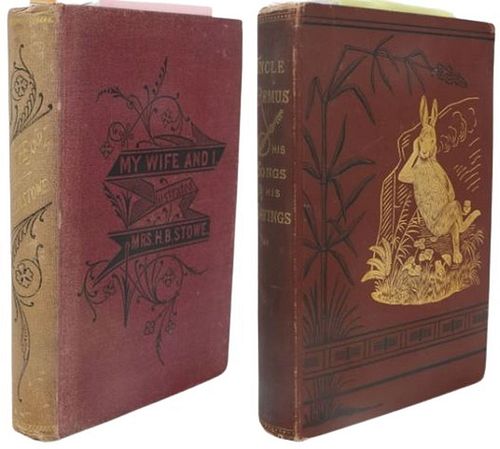Books by Joel Chandler Harris and Harriet B...
About Seller
522 South Pineapple Avenue
Sarasota, FL 34236
United States
Sarasota Estate Auction specializes in a wide variety of furniture, antiques, fine art, lighting, sculptures, and collectibles. Andrew Ford, owner and operator of the company, has a passion for finding the best pieces of art and antiques and sharing those finds with the Gulf Coast of Florida.
Two ways to bid:
- Leave a max absentee bid and the platform will bid on your behalf up to your maximum bid during the live auction.
- Bid live during the auction and your bids will be submitted real-time to the auctioneer.
Bid Increments
| Price | Bid Increment |
|---|---|
| $0 | $10 |
| $100 | $25 |
| $250 | $50 |
| $1,000 | $100 |
| $2,500 | $250 |
| $7,500 | $500 |
| $20,000 | $1,000 |
| $50,000 | $2,500 |
| $100,000 | $5,000 |
| $250,000 | $10,000 |
About Auction
Jan 20, 2024
Artists to include: Jorge Blanco, Leonardo Nierman, Picasso, LeRoy Neiman, Darrell Crisp, Francois Krige, Mino Delle Site, Peter Max, Edward Povey, Sky Jones, Robert Rauschenberg, and others. There are also 7 Original Charles Schulz Drawings done by Reuben Timmins, Production Cels, over 200 lots of Important Books and Manuscripts, Sterling Silver, a Jane Kostick Geometric Wooden Sculpture, Modern Design and Furniture, Fantastic Estate Jewelry, and so much more! Sarasota Estate Auction sarasotaestateauction@gmail.com
- Lot Description
Books by Joel Chandler Harris and Harriet Beecher Stowe. This small lot consists of two books by important authors whose lives were lived right after the American Civil War. Harriet Beecher Stowe wrote "My Wife And I" and Joel Chandler Harris wrote "Uncle Remus", the two books being offered here. Harriet Beecher Stowe (1811 - 1896) was an American author best known for writing "Uncle Tom's Cabin", which depicted the harsh conditions suffered by slaves in America in the 1800's, and she was also an abolitionist whose fame drew national attention. "My Wife And I" was published in 1871 and this is a second edition copy published by J. B. Ford in 1872. The book has a slanted title on the spine, as called for, a decorated cover with black highlights, slate blue endpapers, a beautifully illustrated frontispiece protected by a tissue guard, the title page reads "My Wife And I, Or, Harry Henderson's History" and dated 1872 at the bottom of the page, the copyright page is dated 1871, with a three-page Preface and two pages of Contents, the text is 474 pages long, and there are seven pages of ads at the rear for books published by J. B. Ford. This is also the revised edition containing the addition of "So that the stranger . . . younger women" appears on pages 1565 and 157, according to BAL, and the deletions have been made on pages 236 and 237 to correct the page numbering. See BAL 19474 and BAL 19462, and the book is Harriet Beecher Stowe's comments on the role of women, reform, and domestic politics. You can see that very clearly on the illustrations in the book. Joel Chandler Harris (1848 - 1908) was an American author and folklore teller best known for his collection of Uncle Remus stories. Born in Georgia, where he served as an apprentice on a plantation when he was a teenager, later he worked as an associate editor at the Atlanta Constitution. He led two lives: one as the editor and journalist known as Joe Harris, who supported a vision of the New South, which supported regional and racial reconciliation after Reconstruction, and the other as Joel Chandler Harris, fiction writer and folklorist who wrote many Bre'r Rabbit stories he compiled based on the oral tradition of African-American history being passing down by word of mouth. The title here is "Uncle Remus, His Songs And His Sayings, The Folk-Lore Of The Old Plantation", published in New York by D. Appleton in 1882, with illustrations by Frederick S. Church and James H. Moser. It was the authors first book, and the brown cloth has the title in gilt lettering on the spine and the bright gilt image of Bre'r Rabbit on the front cover, the floral endpapers have a Hoar bookplate plate on the front paste-down, then an illustrated frontis of Uncle Remus by Moser and the title page which is dated 1882 at the bottom, the copyright page is dated 1880 (although the first edition actually came out in 1881), a ten-page Introduction, three pages of Contents, 231 pages of text, and eight pages of ads at the rear for books put out by Appleton. The tales were written in dialect, and Uncle Remus was an older former slave who tells the stories to children gathered around him, like the traditional African griot, and Bre'r Rabbit was the main character who was clever and prone to tricks and troublemaking. See BAL 7100. The Stowe book is 8vo. and measures 7 5/8 x 5 3/8 in. wide, with a tight binding and clean pages and text. There are bumps and light wear on the heel and crown of the spine, faint spots on the front cover, which is faded along the edge of the spine, a small white spot and light fading along the spine on the back cover, and specks of rubbing at the tips, and still an attractive book by one of America's most important novelists. The Uncle Remus book is also 8vo. and measures 8 x 5 1/8 in. wide, with a good binding and clean pages and text. There is wear at the crown and heel of the spine, traces of rubbing along the edges of the spine, light wear at the tips, and a couple of tips are turned in. The front gutter has a bit of wear and a small chip on the edge of the front flyleaf, and there are faint browns spots here and there, but they are few and far between, and the book is an important chapter in African American history and folklore. #30 #7047
- Shipping Info
-
SHIPPING INFORMATION·
Sarasota Estate Auction IS NOT RESPONSIBLE FOR SHIPPING. All shipping will be handled by the winning bidder. Sarasota Estate Auction recommends obtaining shipping quotes before bidding on any items in our auctions. If you are interested in obtaining any information on local shippers, please send us an email and we will kindly send you a list of local shippers. Refunds are not offered under any circumstances base on shipping issues, this is up to the buyer to arrange this beforehand.
Premier Shipping, info@premiershipment.com
BIDDER MUST ARRANGE THEIR OWN SHIPPING. Although SEA will NOT arrange shipping for you, we do recommend our shipper Premier Shipping & Crating at info@premiershipment.com You MUST email them, please do not call. If you'd like to compare shipping quotes or need more options, feel free to contact any local Sarasota shippers. You can email any one of the shippers below as well. Be sure to include the lot(s) you won and address you would like it shipped to. Brennan with The UPS Store #0089 - 941-413-5998 - Store0089@theupsstore.com AK with The UPS Store #2689 - 941-954-4575 - Store2689@theupsstore.com Steve with The UPS Store #4074 - 941-358-7022 - Store4074@theupsstore.com Everett with PakMail - 941-751-2070 - paktara266@gmail.com
-
- Payment & Auction Policies
-
Available payment options
We accept all major credit cards, wire transfers, money orders, checks and PayPal. Please give us a call at (941) 359-8700 or email us at SarasotaEstateAuction@gmail.com should you have any questions about payment.
-
- Buyer's Premium



 EUR
EUR CAD
CAD AUD
AUD GBP
GBP MXN
MXN HKD
HKD CNY
CNY MYR
MYR SEK
SEK SGD
SGD CHF
CHF THB
THB





























